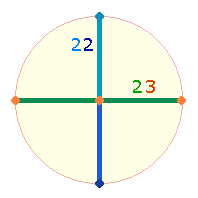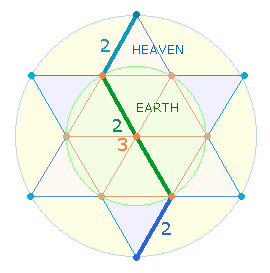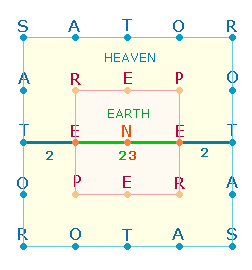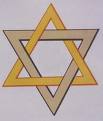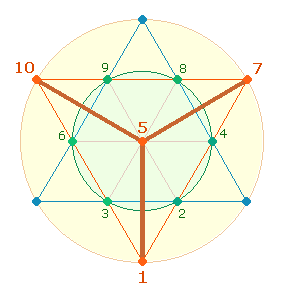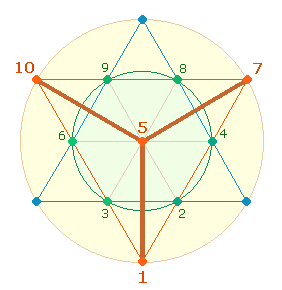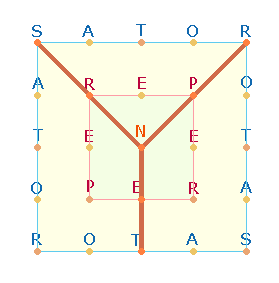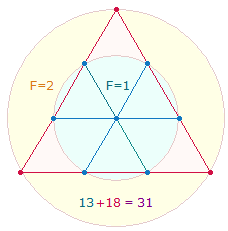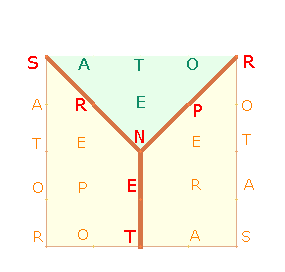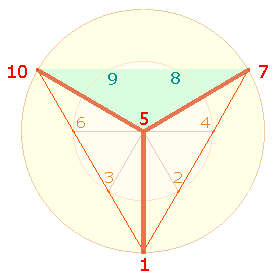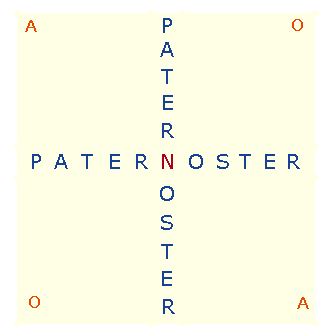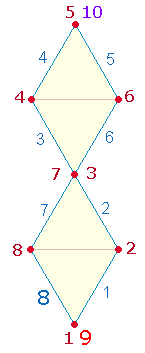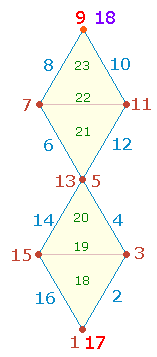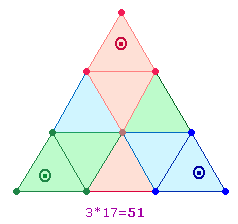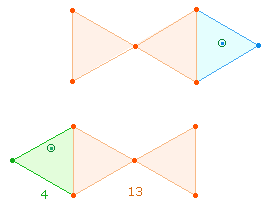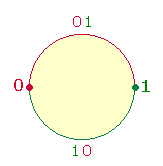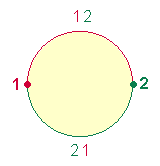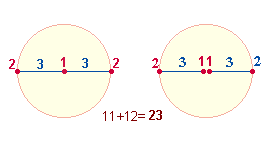Alphabets;
factoral values
Shakespeare's Epitaph
E. Gematric
aspects of the 4 Y-Words;
G. Y-words in
the Angel's Message to Mary
J. The two titles of Jesus in the
Annunciation: Greek and Latin
H. YPSILON SYMBOL OF CROSS AND
SALVATION
I.
Introduction
III.
Ypsilon as a Vessel
b) PATER NOSTER
c) MARIA
d) Synopsis
e) MARIA and the numbers 22, 23
IV. The sums of neighbouring even and
uneven numbers
V. The Son of God and the number 11
VI. The Number 569
|
6 |
GOOD FREND FOR IESVS SAKE FORBEARE |
|
6 |
TO DIGG THE DVST ENCLOASED HEARE. |
|
8 |
BLESTE BE YE MAN YT SPARES THES STONES |
|
8 |
AND CVRST BE HE
YT MOVES MY BONES. |
I. Introduction
1. The previous
part of this study has shown that the results produced by the double count
of the 4 Annunciation words HYIOS HYPSISTOU,
HYIOS THEOU
perfectly fitted the values of Shakespeare's epitaph and separately the
name PENSATOR. Characteristic of both gematric combinations is their
divisibility by 11.
What
astonishes about the 4 words is that the numerical and factoral results of the 23 count (for the letter Y) are even numbers with
interrelating ratios, while the 22 count ends up in the prime number 569. How can this be
explained?
2. Answers to two basic
questions should be found. First, who is to be considered creator of the
gematric results? There is a clear answer to this question: St. Luke would
never have thought of counting gematric values according to the Latin alphabet.
Therefore we have to attribute any meaningful results to God's infinite faculty
of arranging everything "in the background", so to speak.
The
second question is: What legitimate reason can there be to count gematric
values of Greek words according to the Roman alphabet? There may be two
plausible answers:
The Romans had
developed a system of gematric meaning that served the interest of the Roman
state and its identity.
By seizing political
power over
3. But if Greek Y was adopted as 22nd letter of the Latin
alphabet, why does the 23-count make better sense than the 22-count?
Was its sense destined to be perceived as late as in Shakespeare's days when Y was the 23rd letter? This
providential aspect should not be totally ignored, but it would not give a
satisfying answer.
Answers
may not be stringently substantiated, but at least approached in various
aspects, which will imply going into some detail.
II. Cross and Salvation
1. The Niceno-Constantinopolitan
Creed says about Jesus Christ:
|
Qui propter nos homines et propter nostram salutem
descendit de cζlis. |
who
for us men, and for our salvation , came down from heaven, |
|
Et incarnatus est de Spiritu Sancto ex Maria Virgine,
et homo factus est. |
and
was incarnate by the Holy Ghost of
the Virgin Mary, and was made man; |
|
Crucifixus etiam pro nobis sub Pontio Pilato; passus,
et sepultus est, |
he was crucified for us under Pontius Pilate,
and suffered, and was buried, |
|
et resurrexit tertia die, secundum Scripturas, |
and
the third day he rose again, according
to the Scriptures, |
By becoming
man, Jesus Christ connects a) Heaven and Earth, b) Divine
and Human nature. His mission is to reconcile the World with God. He does so by
sacrificing his life to his Father for the sins of Mankind. There is no Salvation without the Cross. The Cross means hardship
and pain,
Salvation means harmony between Man and God.
2. The numbers 22 and 23 are the numeric
equivalents of Christ's uniting task and double nature. If the two numbers are
taken as single digits 2+2 and 2+3, the nearest geometrical model will be the cross
itself with its 4 radial lines and 5 points:
|
|
In the beginning God created
the heavens and the earth, says the Bible in the Book Genesis. According to the
order of the numbers 22 23 the construction of the cross
begins with the vertical axis. But against the normal principle of construction
the central point is assigned to the horizontal axis. This shows that the
creation was performed for the sake of the earth and for the sake of Man, God's
image. Accordingly, God's Word descended from heaven to become a human being
and to reconcile the World with God by undergoing the CROSS, which, according to
the Elizabethan alphabet, has the same numerical value (NV) 70 as IESUS.
3. The main geometrical
models are the hexagram with 2 concentric circles and the
|
|
|
The outer concentric
area with 2
measures (lines) and 2 points represent Heaven, the inner square Earth with 2 measures and 3 points.
4. The geometrical
construction of 2 tetraktys is known as hexagram (HxG) or Star of David. The
two intertwined triangles are understood to symbolise the close interrelation
between God and his Creation, especially Man:
|
|
The shape of Y can be fitted into 3 corners and the centre
of the lower triangle:
|
|
This
shape of Y
resembles a human figure with arms spread and legs kept together and can be
associated with the crucified Jesus Christ. The three radial lines testify to
Christ's teaching of the trinitarian God, whom he represents. His arms and body
encompass the universe, so by his death and resurrection he is the originator
of a new creation, in which proportions are harmonious.
The sum
of the 4 numbers covered by the shape of the Y is 23, the 6 numbers on the arc of the hexagon circle amount to
the inversion value 32.
5. The three lines of the
letter Y intersect the arc of the hexagon circle and the inner frame of the
|
|
|
In concordance with the
1+(3*4) = 13 elements, the added values of the 7 letters covered by the
Y in the
|
|
SATOR Square |
HG |
sm. |
||||
|
|
|
N |
RRE |
SPT |
|
|
|
|
NS |
*13 |
1 |
3 |
4 |
104 |
23 |
127 |
|
|
|
|
RRTE |
SPN |
|
|
|
|
FS |
*29 |
|
2 |
1 |
87 |
20 |
107 |
|
|
|
|
|
|
|
|
234 |
|
234 = 18*13 |
|
||||||
The factoral values (FV) of the
The three hexagon axes
are held together by three sides of the tetraktys consisting of 18 elements. The addition
13+18 leads up to the inversion number 31:
|
|
As the centre values N+5 of both figures amount
to 18, it might be interesting if there are groups of numerical sums (NS) and factoral sums (FS) which are divisible by
18. In fact, 5 groups can be found for
11 values:
|
|
5 N |
E S |
1 R |
7 10 P |
R T |
|
|
NS |
18 |
23 |
18 |
32 |
36 |
|
|
FS |
18 |
13 |
18 |
22 |
36 |
|
|
*18 |
2 |
2 |
2 |
3 |
4 |
13 |
The shape
of Y can be fitted into the
III. Ypsilon as a Vessel
a) The two vessels
1. If the two rising arms
of the Y
are understood as a cup, its inside contains 2+4 more numbers:
|
|
|
2. The meanings of this
aspect of Ypsilon are difficult to find out. I will try to weigh them carefully
at the end of this investigation.
The
additional values turn out surprising results.
b) PATER NOSTER
1. The NS of the 4 letters of the
SATOR-cup is 39 = 3*13. The 7+4 letters of the Ypsilon figure make up the total NS 13*(8+3) = 143. This means that the
average NV
for each of the 11 letters is 13. As there is also an
average FV of 11, the FS:NS ratio is 11*(
These 11 letters can be
rearranged to form the words PATER NOSTER Our Father. It was a major
discovery in the twenties of last century that the 25 letters of the
|
|
The cross
leaves twice the letters A and O, which gave rise to a lot of discussion about the
origin of the
2. There is a remarkable NS+FS ratio between the 11 letters of PATER
NOSTER and
the remaining 14 letters:
|
|
NS |
FS |
sm |
|
11 lts. |
143 |
121 |
264 |
|
14 lts. |
160 |
128 |
288 |
|
264:288= 24*( |
|||
c) MARIA
1.
The hexagram Y offers the real surprise: Both
the numerical and factoral values coincide with those of MARIA, mother of Jesus
Christ:
|
|
M |
A |
R |
I |
A |
sm |
|
NV |
12 |
1 |
17 |
9 |
1 |
40 |
|
FV Lts. |
7 |
1 |
17 |
6 |
1 |
32 |
|
|
8:13=21 |
24:27=51 |
72 |
|||
|
HxG |
5+8 |
7+10 |
9 |
1 |
40 |
|
|
FV Nrs. |
11 |
14 |
6 |
1 |
32 |
|
|
|
|
31 |
|
31 |
||
|
|
24 |
|
17 |
41 |
||
|
|
24 |
48 |
72 |
|||
The NS+FS 72 is identical with the NV of Greek HYIOS Son.
The
results especially show a 2:3 ratio of letters with regard to the added NS+FS 24:48 =
24*(1:2). The ratio numbers add
up to 3 and 5.
The NS+FS ratio of PATER
NOSTER and
MARIA is 24*(11:3) = 336.
The average value for each of the 16 letters is 21.
The
number 336 is the NS+FS of the numbers 1-19: 190+146. It's also the FS of the Roman Trias
Capitolina IUPPITER OPTIMUS MAXIMUS, IUNO REGINA, MINERVA. The NV for IUPPITER is 109, which can be understood
to be composed of 10+9.
The
number 336 is also a combined sum of the inversion numbers (12+102)+(21+201) =
6*(19+37).
One third of 336 is 112, the NV of CHRISTUS. Any other inversion numbers
added according to the given pattern provide a sum divisible by 112.
2. The numbers 8+9 of the cup's inner
space give an explanation for the consonants M and R: The letter R corresponds to the NV 8+9 = 17, the letter M to their FV 6+6 =
12. The
equivalent of the difference 17-12 = 5 is the letter E. The letters ME may have special
meaning in the Epitaph's Y-words.
The NV of 17and 12 are 17+7 = 24. The total sum is 53, which repeats the ratio numbers 3 and 5 from above.
3. MARIA proves to be God's
perfect creation of his Cosmic Order.
d) Synopsis
1. The names PATER
NOSTER and
MARIA suggest that the
contents of the two cups refer to IESUS, God's and Maria's son. Their NS is 143+40+70 =
253 = 11*23. 253 is the sum of the
number 1-22. Here the relatioship
of the numbers 22 and 23 becomes evident.
The
corresponding FS is 121+32+36 = 189 = 9*21, which means an average value of 9 for each of the 21 letters.
2. The relation between PATER
NOSTER and
MARIA becomes evident, if
the FV of the NS and FS are added:
|
|
NS |
FS |
FV1 |
FV2 |
|
|
PN |
143 |
121 |
24 |
22 |
310 |
|
MR |
40 |
32 |
11 |
10 |
93 |
|
|
|
|
|
|
403 |
|
310:93 = 31*(10:3) = 31*13 |
|||||
3.
God's and Mary's son takes his identity from both, which
is represented by the content numbers of the cups. Their values are:
|
|
NS |
FS |
sm |
|
HxG |
17 |
12 |
29 |
|
SQ |
39 |
34 |
73 |
|
|
56 |
46 |
102 |
The NS+FS 102 is the same as the NS of YPSILON and PENSATOR, the eternal judge. In
fact, the Christian Creed says about Jesus Christ:
Et iterum venturus est iudicare vivos et mortuos.
And he will come again to judge the living and the dead.
4.
If God and Mary are represented by the figure of YPSILON, then their son Jesus
is symbolically the YPSILON as well. The values of
the cups and of the Greek word HYIOS Son relate proportionally
to each other:
|
|
NS |
FS |
sm |
|
HXG+ SQ (22) |
56 |
46 |
102 |
|
HYIOS (23) |
72 |
66 |
138 |
|
|
128 |
112 |
240 |
|
112:128 = 16*(7:8) |
|||
The two
compared values are composed of the NS+FS of the numbers 1-7, 1-9,
1-10:
|
|
NS |
FS |
sm |
|
1-7 |
28 |
27 |
55 |
|
1-9 |
45 |
39 |
84 |
|
1-10 |
55 |
46 |
101 |
|
|
128 |
112 |
240 |
5.
The NS+FS of PENSATOR and YPSILON are divisible by 11, if Y is counted 23 and 22. The 22-count 11 less:
|
|
NS |
FS |
sm |
|
NS |
FS |
sm |
|
PENS |
102 |
80 |
|
PENS |
102 |
80 |
182 |
|
YPS (23) |
103 |
78 |
181 |
YPS (22) |
102 |
68 |
170 |
|
|
205 |
158 |
363 |
|
204 |
148 |
352 |
|
363:352 = 11*(35:36) |
|||||||
Both
counts of the Y add up to 351 = 27*13, which is the sum of
the numbers 1-26. The ratio 182: 351 is 13*(
6.
If the NS and FS of both Y-figures are added separately, the
results are:
|
|
NS |
FS |
sm |
|
HXG |
143 |
121 |
|
|
SQ |
40 |
32 |
|
|
|
183 |
153 |
336 |
|
153:183=3*(51:61) |
|||
In the
context of the
e) MARIA and the numbers 22, 23
The name MARIA and the numbers 22 + 23 have the same ratio of
their FS and NS:
|
|
NS |
FS |
sm |
|
|
22+23 |
45 |
36 |
81 |
9*(5:4) |
|
MARIA |
40 |
32 |
72 |
8*(5:4) |
|
|
85 |
68 |
153 |
|
|
68:85=17*(4:5) |
||||
The
internal ratio is 4:1. If the two ratios are related to
the two concentric circles of the Hexagram, the area ratio is 1:3.
MARIA fills the 8 lines of the double rhombus:
|
|
IV. The sums of neighbouring even and uneven numbers
1. A number is also
defined by the sum (sm) achieved by adding up all numbers from 1 up to that number,
e.g. from 1-22. The formula is
sm = x/2*(x+1)
In the
case of an even (E) and the following uneven (UE) number, half the even
number is multiplied with the uneven number:
smE = E/2*UE
smUE = (E+2)/2*UE
With
regard to 22 and 23 the two products are 11*23 and 12*23.
2. The two multiplications
show that an even number has a disposition to belong to the following uneven
number.
The combined NS+FS of the two numbers
are:
|
|
NS |
FS |
sm |
|
|
22 |
253 |
188 |
431 |
|
|
23 |
276 |
201 |
477 |
|
|
|
529 |
389 |
918 |
9*102 |
The total result
divided by 9 is 102 and so identical with the NV of YPSILON and PENSATOR. It strongly refers to
a numbered double rhombus (DR) that is folded at its two ends to
be shaped to an octahedron with a second DR:
|
|
In its
unconverted state the remaining 6 middle elements run up to the number 23. The number 22 refers to twice 11 elements for one rhombus.
3.
The tetraktys and the double rhombus are part of the one
geometrical figure of the hexagram. There is a rich interrelation between the
two so that most referable numbers have a place in both figures. The FS 389, which is a prime
number, can mean the numbered frames of 3 DR so that the sum of
elements is 3*17 = 51, or three fish-like figures in a tetraktys:
|
|
As there are two tetraktys,
the total number of elements is 102. The same applies to
the 3 DR with two equal figures seen from each end:
|
|
V. The Son of God and the number 11
1. The New Testament gives
two definitions about Jesus Christ:
In his
epistle to the Colossians St. Paul says: He is the image of the invisible God
(1,15).
The
second definition may cause some difficulty. According to the Creed the
Almighty Father is the Creator of Heaven and Earth (factorem caeli et terrae),
but it also says that everything was created through him (per quem omnia facta
sunt).
The last
statement is derived from the pologue of
Through
him all things were made; without him nothing was
made that has been made.
How can Jesus
Christ,
according to these definitions, be represented by Number and Geometry?
2.
The circle seems to be the right model. If the arc of a circle
is divided into exactly two halves, the second half can be understood as the
mirror image of the first. If the two dividing counterpoints are numbered, two
possible concepts can be applied: If the two halves of the arcs are seen as
measures, the first measure is completed, when the second point is arrived.
Therefore the first point is numbered 0, the second 1. However, if the the
aspect of measure is neglected and the number of points is concerned, the first
point is numbered 1, the second 2:
|
|
|
3. According to this
concept, the Second Divine Person completes the second half of what the First
Divine Person has started.
The
number of the "Almighty Father" so is 1, of Jesus Christ 10. The sum 11 shows two neighbouring
numbers 1 to denote the same nature and image of Father and Son. At the same
time two numbers 1 also imply the Second Person himself as necessarily
connected with the First.
The same
principle applies to the numbers 12 and 21, which include the Third Person as well.
4. If the Second Person
closes the circle, he can be associated with
5.
The NS+FS of the two numberings achieve the
following results:
|
01 |
12 |
total |
||||||
|
NS |
FS |
sm |
NS |
FS |
sm |
NS |
FS |
|
|
01 |
1 |
2 |
12 |
7 |
19 |
13 |
8 |
21 |
|
10 |
7 |
17 |
21 |
10 |
31 |
31 |
17 |
48 |
|
11 |
8 |
19 |
33 |
17 |
50 |
44 |
25 |
69 |
Possibly
the
By a remarkable
coincidence, the FV of HOMO Man is 31, the NV 48.
The values 31
and 17 of the table represent an external relation (31+17 = 48), in the case of HOMO it is internal (31+17 = 48).
6.
The inversion numbers 01 and 10 are also to be found
in the relation between the numbers 22 and 23. The numeric value
proceeds by 1, the factoral value from 13 to 23 by 10.
Salvation is so a cooperative task of Father and Son.
VI. The Number 569
1.
The NS+FS of the 4 Annunciation words HYIOS
HYPSISTOU, HYIOS THEOU is according to the 22-count of Y 351+218 = 569, which is a prime
number. The number has to be read as single digits (5+6)+9, which refer to the
elements of a cross.
2.
The diameter of a circle is composed of two radial
measures or lines with a common centre point. It consists of 5 elements. One radial
measure is delimited by the centre point and an arc point, so it consists of 3 elements. In this way
a double aspect arises from 5 diametrical elements and 2*3 = 6 radial elements:
|
|
3.
A cross of two axes should consist of 2*5 = 10 elements. But with only one centre point it's just 9 elements. To compensate the deficient element, a second
cross must be imagined with 5 diametrical and 6 radial elements so that the total sum of elements is 2*10 = 20:
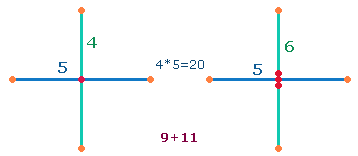
4.
The deficient element of the first cross can be
interpreted as the defect in human nature contracted by the disobedience of the
first couple in paradise. Jesus Christ sacrifices his life on the cross in
compensation for the sins of mankind so that through him a new communion
between man and God is established.
The numbers 5 and 6 can be regarded as centres
of 9 and 11 points on a linear scale in order to delimit 8 and 10 measures:
|
|
|
|
These two
models may also account for the significance of the number 18.
5.
If the diametrical elements are to be numbered, 1 is assigned to the
centre, 2 to the arc points and 3 to the connecting lines. The numbered sum of the
diametrical elements is 11 and the radial elements 12:
|
|
A
numbered cross of axes with 1 centre adds up to the sum 21, which must be
compensated by another cross with the sums 11+12 so that 21+23 amount to an average
sum of 22 for each of the two crosses.
If the
fullness of theological meaning lies in the combination of the two double
counts, the addition is (5+6)+(11+12) = 11+23 = 34, which multiplied by 3 in the case
of the three axes of the hexagon totals 102.
Written: February 2009
